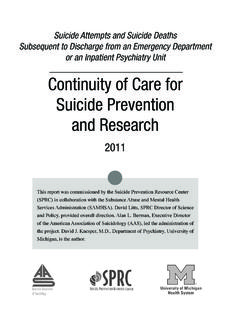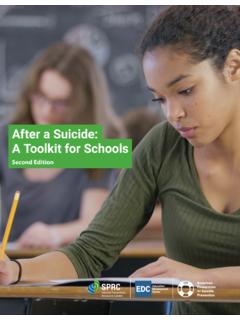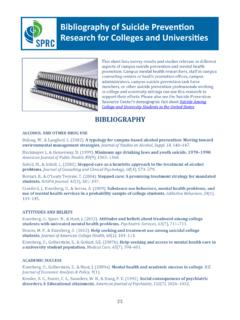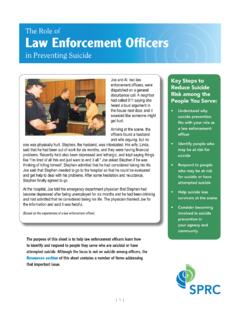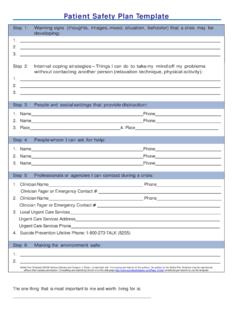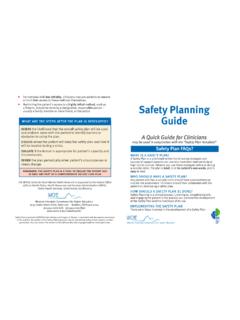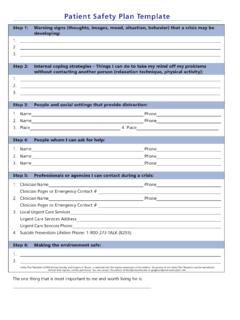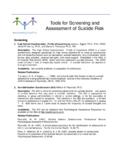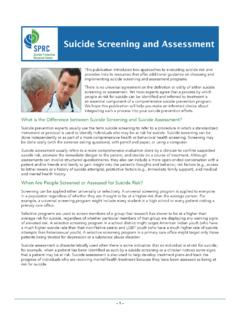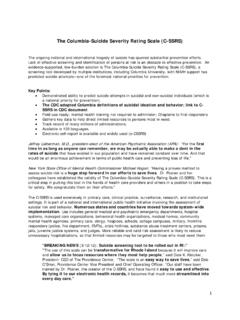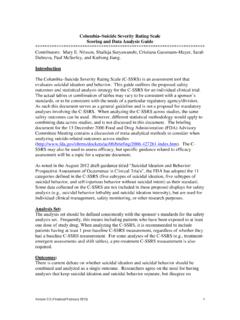Transcription of Caring for Adult Patients with Suicide Risk - SPRC
1 Caring for Adult Patients with Suicide RiskA Consensus Guide for EmergencyDepartmentsSuicide Prevention Resource CenterSPRCC aring for Adult Patients with Suicide Risk: A Consensus Guide for Emergency Departments (the full and quick guide versions) is based upon the best information available at the time of publication. It is designed to provide information and assist decision-making and act as a guideline only. It is not intended to define a standard of care and should not be construed as one. Neither should it be interpreted as prescribing an exclusive course of management. Variations in practice will inevitably and appropriately occur when providers take into account the needs of individual Patients , available resources, and limitations unique to an institution or type of practice.
2 Every health care professional making use of these guidelines is responsible for evaluating the appropriateness of applying them in the setting of any particular clinical Panel Members 2015 Education Development Center, Inc. All rights Allen, MDCara AnnaGary Behrman, PhD, LCSWJon Berlin, MDLanny Berman, PhDEdward Bernstein, MD, FACEPEmmy Betz, MD, MPHE dwin Boudreaux, PhDEdward Boyer, MD, PhDPeter Brown, MAGreg Brown, PhDMarilyn Bruguier Zimmerman, MSWS tuart Buttlaire, PhD, MBAJoel Carr, PhD, LCSW, LPCJ ennifer Chaffin, MDCindy Claassen, PhDM. Justin Coffey, MDMaureen Cooper, MSN, RNGlenn Currier, MD, MPH Susan De Luca, PhD John Draper, PhDKen Duckworth, MDAvrim Fishkind, MDAmy Goldstein, PhDPeter Gutierrez, PhDJill Harkavy-Friedman, PhDCharles R.
3 Harman, MSMatt Havens, MSW, LCSWLisa Horowitz, PhD, MPHD arcy Jaffe, MN, ARNP, NE-BC, PMHCNS-BCBarbara Kaminer, LCSWS helby Kneer, MSW, LCSWD avid Knesper, MDRandolph Knight, MD, FACEPGail Lenehan, EdD, MSN, RN, FAEN, FAANDeQuincy Lezine, PhDMary Nan Mallory, MDAnne Manton, PhD, APRN, FAEN, FAAN Richard McKeon, PhD, MPHVan Miller, PhD James Mitchiner, MD, MPHG illian Murphy, PhDMarlene Nadler-Moodie, MSN, APRN, PMHCNS-BCMeera Narasimhan, MDStephen O Connor, PhDMary Ellen Palowitch, RN, MHASeth Powsner, MDLaura Raymond, BSN, RN, CEN Brett Schneider, MD, LTC, MCSusan Self, MSW, LCSW, CCWM orton Silverman, MDChris Souders, MDBarbara Stanley, PhDLauren Whiteside, MD, MSRichard Wild, MD, JD, MBA, FACEPM ichael Wilson, MD, PhD, FAAEMM atthew Wintersteen, PhDDoug Zatzick, MDScott Zeller, MDLeslie Zun, MD, MBA, FAAEMC ontents1.
4 About the Guide .. Introduction Key Components of Caring for Adult Patients with Suicide Risk in EDs 22. Decision Support Tool .. About the Decision Support Tool Using the Decision Support Tool Comprehensive Suicide Risk Assessment 73. ED-Based Brief Suicide Prevention Interventions .. Brief Patient Education Safety Planning Lethal Means Counseling Rapid Referral Caring Contacts Crisis Center Information 154. Discharge Planning Checklist ..165. Providing Patient-Centered Care ..186. Support for the Emergency Department .. Documenting the ED Visit Working with Crisis Centers Using Telepsychiatry with Suicidal Patients Suicide Risk Associated with Intoxication and Substance Use Disorders Reducing Liability Concerns 23 Appendices.
5 27 Appendix A: Quick Guide 28 Appendix B: Guide Resources and URLs 29 Appendix C: Primary Screening and Suicide Risk Assessment 30 Appendix D: Sharing Patient Health Information 32 Appendix E: Sample Letter to Outpatient Mental Health Providers 35 Appendix F: Community Resource List Template 37 Appendix G: Caring Contacts Sample Materials 38 Appendix H: Key Elements of a Patient Care Plan 40 Appendix I: Examining Your Views about Suicide 41 References 42 Acknowledgments ..44 [I]t is important to recognize that suicidal experiences exist on a continuum. Some people have seriously considered Suicide , some have made plans that were not carried out, and some have attempted Suicide . Of the millions of people who have lived through a suicidal crisis, the vast majority recover.
6 The Way Forward: Pathways to Hope, Recovery, and Wellness with Insights from Lived ExperienceCaring for Patients with Suicide Risk | 11 About the Introduction Caring for Adult Patients with Suicide Risk: A Consensus Guide for Emergency Departments (the ED Guide) is designed to assist emergency department (ED) providers with decisions about the care and discharge of Patients with Suicide risk. Our main goal in developing and disseminating this guide is to improve patient outcomes after discharge. Studies indicate that the risk of a Suicide attempt or death is highest within the first 30 days after discharge from an ED or inpatient psychiatric unit. Yet for many reasons, up to 70 percent of Patients who leave the ED after a Suicide attempt never attend their first outpatient appointment (Knesper, 2010).
7 ED providers are in a unique position to improve outcomes and facilitate a safer discharge for Patients with Suicide risk by providing them with brief interventions, onsite mental health consultations when appropriate, and linkages to sources of follow-up care. Research suggests that ED-based interventions could reduce annual deaths from Suicide by 20 percent (National Action Alliance for Suicide Prevention: Research Prioritization Task Force, 2014). The ED Guide provides information about decision support, brief interventions, and discharge planning with Adult Patients who have been identified as having some risk of Suicide . It can also help answer the following questions: Can this patient be discharged or is further evaluation needed?
8 How can I intervene while this patient is in the ED? What will make this patient safer after leaving the ED?A Quick Guide version of this document is in Appendix A. We recommend providers read the complete version before using the Quick Guide. A comprehensive set of external resources, referenced in this guide, can be accessed by clicking on the blue text or viewing the list of resources in Appendix B. The ED Guide was written for health care professionals ( , physicians, nurses, mental health specialists, and other practitioners) who provide clinical care in EDs, although some topics may be appropriate for ED and hospital administrators. The authors recognize that clinical roles vary across EDs, therefore institutions can adapt the recommendations given here to their own organizational structures.
9 In this guide, all relevant health care professionals are referred to as provider. All clinical information provided in this guide is meant to complement, not replace, provider S INSIDE: Key components of Caring for Adult Patients with Suicide risk in EDs Decision Support Tool Section 2 ED-based interventions Section 3 Discharge planning checklist Section 4 Patient-centered care guidelines Section 5 Information on related topics, such as documentation, working with crisis centers, and intoxication and substance use disorders Tools and resources to support implementation of the ED Guide Caring for Patients with Suicide Risk | 2 The ED Guide was developed with extensive input from a consensus panel of experts from emergency medicine and Suicide prevention organizations, including people who lived through suicidal experiences ( , lived experience.)
10 Recommendations in the ED Guide were developed using an iterative process that included both reviews of the literature and expert panel consensus. For more on how the ED Guide was developed, see the companion paper, Technical Report: Developing Caring for Adult Patients at Risk of Suicide : A Consensus Guide for Emergency Departments. Key Components of Caring for Adult Patients with Suicide Risk in EDsFigure 1 illustrates one process for the care and discharge of Adult Patients with Suicide risk from EDs. This process emphasizes the actions and decisions that are most relevant for the discharge of Patients in lower-risk categories. The items shaded blue are consensus-based tools and resources provided in this guide.
